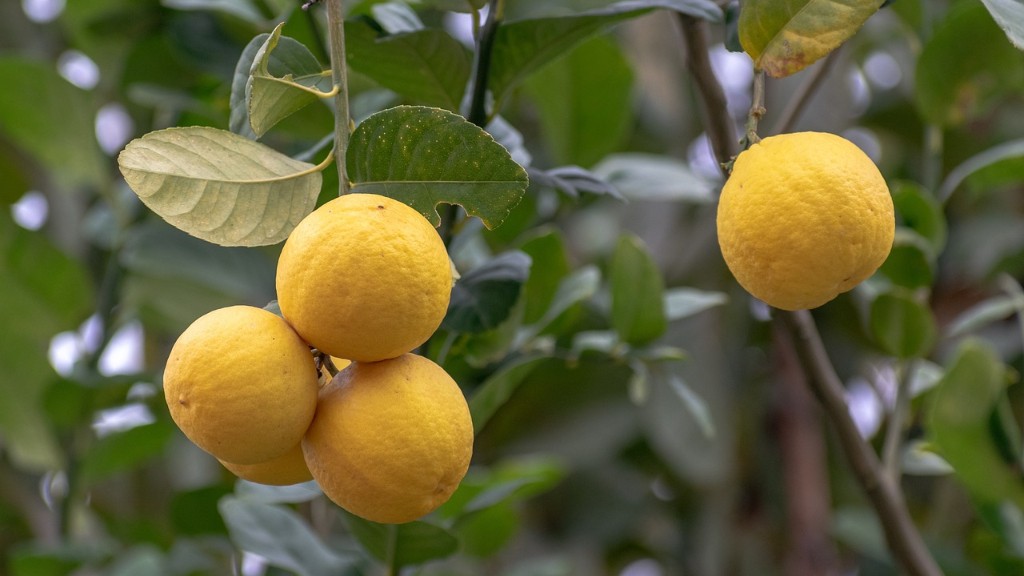Lemons are a delight to the eyes, not to mention the tongue! They are a versatile citrus fruit with many uses, from flavoring to cleaning. If you have ever wondered how lemon trees grow, you have come to the right place. Read on to find out what it takes for a healthy lemon tree to form and prosper.
First and foremost, lemon trees require a soil with ample drainage and adequate moisture. A good soil should be alkaline, at a pH of around 6.5 to 7. A light loam with some organic mixture is ideal for lemons, helping the lemons develop properly and keep the tree healthy. Nutrients for the tree to thrive come in the form of nitrogen, phosphorus, and potassium. It is important to fertilize regularly to ensure their growth.
When planting a lemon tree, the ideal spot is an area in full sun. Lemons require sunlight to drive growth and should receive at least 6-8 hours a day. Also, when planting, take care to ensure the root system is buried beneath the soil as opposed to remaining exposed. Planting a flowering variety of lemon tree is a great idea too, as they will produce flowers with a sweet scent.
One of the hallmarks of a healthy lemon tree is its vigorous growth. To achieve this, pruning the tree is essential. Pruning helps to keep the tree from becoming overgrown and allows for better air circulation. Additionally, pruning causes more branches and leaves to appear, forming a dense foliage. Another good habit for optimal lemon tree growth is to get rid of weeds and other pests around the tree’s vicinity.
The deeper a lemon tree is watered, the more beautiful the fruits borne will be. Watering the tree correctly and consistently allows it to soak up the necessary nutrients from the soil. Every part of the tree needs to be kept hydrated, from the roots to the growing tips. Mulching the tree can help to retain the soil’s moisture during the warmer months.
Overall, lemon trees may require a bit of dedication and care, but it is worth it when the end results are seen. Ensuring it is in the right soil and getting plenty of sun is a crucial part of growing a lemon. With regular pruning and watering, a lemon tree can thrive, producing sweet and flavorful fruits that are ideal for many culinary and medicinal applications.
Methods For Lemon Tree Propagation
Propagating a lemon tree is a great way to increase your current tree. Through cultivation, cuttings, air layering, and grafting, a lemon tree may be multiplied and produce more fruits. This can be done through implementing practices that stimulate root formation.
From cuttings, lemon trees can be asexually propagated–cuttings are simply taken from the higher branches of the tree and inserted in soil withrooting hormone. These cuttings are then covered with a plastic bag and kept moist. After a few weeks, the cuttings will have produced roots and can be transplanted.
Air layering is another popular method to propagate a lemon tree, with the branch and bark being sliced slightly, ringed, and enclosed in a plastic bag, covered with damp compost and soil. After a few months,roots will start to form, and the cut branches are cut off and planted separately.
Finally, grafting lemon trees has proven to be an effective method of propagation as well. This method involves cutting off a piece of the desired tree and splicing it with a tree that has a good root system. If the grafted tree is then placed in a sheltered and well-lit area, it can be successful.
Harvesting Lemon Fruit
Harvesting lemons from a lemon tree is a process that varies depending on the type of lemon. Generally, the color of the lemon should be a light yellow when ready to be picked. Additionally, the surface should have some firmness to it and the stem should resist being pulled off the tree.
When harvesting a lemon, a pair of sheared or regular gardening scissors can be used. However, make sure to not cut too close to the tree as this may cause damage. Also, it is best to avoid shaking the tree as it can damage the delicate fruits.
Once the lemons have been harvested, they can be sun-dried or placed in a cool and dry area away from direct sunlight. This will keep them from rotting and tasting their best. Additionally, when the lemons turn a yellowish-brown color, they are ready for picking and should be used within a few days for the optimum flavor.
Care Of The Lemon Tree Throughout The Seasons
The lemon tree will require some attention depending on the season. During winter, the tree must be kept above freezing and away from cold winds to avoid frost. To protect the tree during the winter months, it can be covered with a plastic sheet and mulch. Furthermore, covering the tree can help it to retain warmth, which can be beneficial when temperatures drop.
When spring and summer arrive, the tree should be fertilized with nitrogen and phosphorus. Pruning and watering should be done regularly as well to maintain a healthy tree. While the tree will grow more in the summer months, it needs to be checked for any pests or diseases in order to detect any damage as soon as possible.
The lemon tree will fare best in warm and sunny temperatures. Excess heat and humidity can potentially damage the tree and fruit, so good air circulation is important. Additionally, when it comes to the fruit, it needs to be picked regularly to help maintain a full-bodied tree and keep the lemons vibrant and flavorful.
Uses Of The Lemon Tree’s Fruits
Lemons and their fruitful combination of juiciness, zest, and acidity, create an unbeatable flavor. And these flavorful fruits have many culinary uses and benefits such as juice, sauces, cake, sorbet, and much more. Lemons can even be used to improve your digestion, strengthen your immunity and treat infections.
Lemons are a great source of vitamins and minerals, including vitamin C, riboflavin, thiamine, and magnesium. Not to mention, they are packed full of antioxidants,which helps boost the immune system. And lemon juice also serves as a ‘natural’ disinfectant and can be used as an all-purpose cleaner.
Lemons have a long history of medicinal uses, such as for treating colds and flu, warding off fever, and relieving sore throat. In fact, lemons and their juice have been used as a digestive aid, while their rind has been used to treat biliousness and heartburn.
Traditionally, lemons were even used as a beauty aid. Lemon juice can be used to lighten hair, remove dandruff, and treat acne. Lemon juice and its fruit acids have also been used to treat pigmentation and wrinkles, giving a natural health and beauty boost.
Lemons are a wonderful, versatile fruit, and can add an extra kick of flavor and health benefit to many dishes. With enough care and attention, a lemon tree may bear plentiful and flavorful fruits, allowing you to reap its countless benefits.




